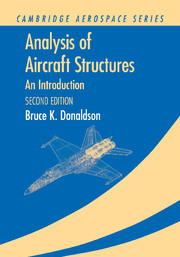Book contents
- Frontmatter
- Contents
- Introduction to the Second Edition
- Introduction to the First Edition
- List of Repeated Engineering Symbols
- Acknowledgments
- Part I The Fundamentals of Structural Analysis
- Part II **Introduction to the Theory of Elasticity**
- Part III Engineering Theory for Straight, Long Beams
- 9 Bending and Extensional Stresses in Beams
- 10 Beam Bending and Extensional Deflections
- 11 Additional Beam Bending Topics
- 12 Uniform Torsion of Beams
- 13 Beam Torsion Approximate Solutions
- Beam Bending and Torsion Review Questions
- 14 Beam Shearing Stresses Due to Shearing Forces
- Part IV Work and Energy Principles
- Part V Energy-Based Numerical Solutions
- Part VI Thin Plate Theory and Structural Stability
- Appendix A Additional Topics
- Appendix B Selected Answers to Exercises
- References
- Index
10 - Beam Bending and Extensional Deflections
from Part III - Engineering Theory for Straight, Long Beams
Published online by Cambridge University Press: 05 June 2012
- Frontmatter
- Contents
- Introduction to the Second Edition
- Introduction to the First Edition
- List of Repeated Engineering Symbols
- Acknowledgments
- Part I The Fundamentals of Structural Analysis
- Part II **Introduction to the Theory of Elasticity**
- Part III Engineering Theory for Straight, Long Beams
- 9 Bending and Extensional Stresses in Beams
- 10 Beam Bending and Extensional Deflections
- 11 Additional Beam Bending Topics
- 12 Uniform Torsion of Beams
- 13 Beam Torsion Approximate Solutions
- Beam Bending and Torsion Review Questions
- 14 Beam Shearing Stresses Due to Shearing Forces
- Part IV Work and Energy Principles
- Part V Energy-Based Numerical Solutions
- Part VI Thin Plate Theory and Structural Stability
- Appendix A Additional Topics
- Appendix B Selected Answers to Exercises
- References
- Index
Summary
Introduction
The use of Eq. (9.8), the strength of materials solution for the bending and extensional axial stress σxx(x, y, z) in a long, straight beam, requires a knowledge of the internal axial force N(x) and the internal bending moments My(x) and Mz(x). The difficulty is that a free body diagram (FBD) of a beam under study is often insufficient by itself to determine the axial force or bending moments at any point along the beam x-axis. As previously mentioned, whenever the equilibrium equations alone are insufficient to determine the internal stress resultants, the structure is called indeterminate. Most beams, or beam elements, that are parts of aerospace structures are indeterminate because these beams are mostly elements of beam grids and frames with, as much as possible, rigid connections. The grids and frames are often covered by thin sheeting, referred to as the vehicle skin. Thus there are many internal unknown reations. One purpose of this type of construction is to make the structure, and hence individual beams, as stiff as possible within the constraint of least weight. Increased stiffness has many advantages in a beam or a structure. For example, the stiffer the beam or structure, the higher the load required to buckle the beam or structure, and the lesser the chance of aeroelastic instabilities such as those discussed in Chapter 9. The stiffer the beam or structure, the higher its natural frequencies and the lesser the chance that gusts or control motions will stress the structure.
- Type
- Chapter
- Information
- Analysis of Aircraft StructuresAn Introduction, pp. 271 - 309Publisher: Cambridge University PressPrint publication year: 2008



